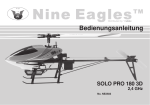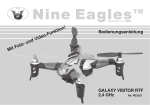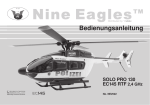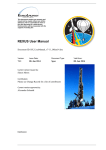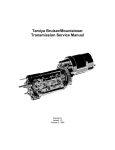Download ROBBE BLUE ARROW Operating instructions
Transcript
Operating Instructions
BLUE ARROW 1.0 3D
RTF
2.4 GHz
No. S2523
Operating Instructions, BLUE ARROW 1.0 3D RTF 2.4 GHz No. S2523
2
Operating Instructions, BLUE ARROW 1.0 3D RTF 2.4 GHz No. S2523
Explanation of specialist terms:
Climb and descent ("collective pitch / throttle"):
This controls the model's climb and descent.
Yaw:
The model's movement around the vertical axis; the
helicopter rotates to right or left.
Pitch axis:
The model's movement around the lateral axis,
forward or reverse flight
Roll:
The model's movement around the longitudinal axis,
sideways movement to right or left
Mode 1:
Function assignment of control movements relative
to the sticks.
In this case collective pitch / motor speed (throttle)
and roll are controlled by the right-hand stick; pitchaxis and tail rotor by the left-hand stick.
Mode 2:
Function assignment of control movements relative
to the sticks.
In this case collective pitch / motor speed (throttle)
and tail rotor are controlled by the left-hand stick;
pitch-axis and roll by the right-hand stick.
Dual Rate:
Switchable travel reduction for control movements.
Binding:
Creating the radio link between transmitter and
receiver.
Contents Explanation of specialist terms / Contents
Safety Notes
Set contents / Specification / Recommended accessories
Transmitter description Mode 1
Transmitter description Mode 2
Transmitter LCD screen / Transmitter settings /
Collective pitch / throttle settings
Motor connections / Flybarless check
Charging the battery / LiPo battery safety notes
Pre-flight preparations
Trim adjustments in Mode 1 / Mode 2
Controlling the model
Important advice / The first few flights
Exploded drawing
Replacement parts
Page No.
3
4, 5
6
7
8
9
10
11
12, 13
14
15
16
17
18, 19
3
Operating Instructions, BLUE ARROW 1.0 3D RTF 2.4 GHz No. S2523
Be sure to read right through these Safety Notes before you build
your model. Always keep to the procedures and settings recommended in the instructions.
If you are operating a radio-controlled model aircraft, helicopter, car
or boat for the first time, we recommend that you enlist the aid of an
experienced modeller to help you.
Safety Notes
Radio-controlled models are not toys in the usual sense of the term.
Young persons under fourteen years should only be allowed to operate
them under the supervision of an adult.
Building and operating these models requires technical expertise, manual skills, a careful attitude and safety-conscious behaviour.
Errors, negligence and omissions in building or flying these models can
result in serious personal injury and damage to property.
Since the manufacturer and vendor are not in a position to check that
your models are built and operated correctly, all we can do is bring these
hazards expressly to your attention. We deny all further liability.
Helicopter rotors, and all moving parts generally, constitute
a constant injury hazard.
It is essential to avoid touching such parts.
Bear in mind that motors and speed controllers may become
hot when operating.
It is essential to avoid touching such parts.
4
Do not stand close to the hazard area around rotating parts when
an electric motor is connected to the flight battery.
You must take care to keep all other objects away from moving
or rotating parts!
Observe the instructions provided by the battery manufacturer.
Overcharged or incorrectly charged batteries may explode. Take
care to maintain correct polarity.
Notes on the use of dry cells:
Do not attempt to recharge dry cells, do not open them, and do
not incinerate them. Remove exhausted dry cells from the transmitter after use. Escaped electrolyte may ruin the transmitter.
Ensure the equipment is protected from dust, dirt and moisture contamination. Do not subject the system to excessive heat, cold or vibration.
Use the recommended charger only, and charge the batteries only for the
prescribed period.
Check your equipment for damage at regular intervals, and replace defective components with genuine spare parts.
Do not re-use any devices which have been damaged in a crash or by
water, even when they have dried out again.
Send the equipment to the robbe Service Department for checking, or
replace the parts in question.
Crash or water damage can result in concealed defects which may lead
to failure in subsequent use.
Operating Instructions, BLUE ARROW 1.0 3D RTF 2.4 GHz No. S2523
Use only those components and accessories which we specifically recommend.
Do not carry out modifications to the radio control system components
apart from those described in the instructions.
Operating the model
•Never fly over or towards spectators or other pilots, and maintain a safe distance from them at all times.
•Never endanger people or animals.
•Never fly or run the model close to high-tension overhead cables or residential areas.
•Do not operate your model in the vicinity of canals, locks or open waterways.
•Do not operate your model from public roads, motorways, paths and squares etc.; use authorised model flying sites only.
Liability Exclusion
robbe Modellsport is unable to ensure that you observe the assembly and
operating instructions, or the conditions and methods used for installing,
operating and maintaining the model components.
For this reason we accept no liability for loss, damage or costs which are
due to the erroneous use and operation of our products, or are connected
with such operation in any way.
Regardless of the legal argument employed, our obligation to pay compensation is limited to the invoice value of those robbe products directly
involved in the event in which the damage occurred, unless otherwise
prescribed by law. This does not apply if the company is deemed to have
unlimited liability according to statutory regulation due to deliberate or
gross negligence.
• Never operate the model in stormy weather.
Never “point” the transmitter aerial straight at the model when operating
it. The transmitter signal is at its weakest in this direction. It is always best
to stand with the long side of the aerial angled towards the model.
Insurance
Ground-based models are usually covered by standard personal thirdparty insurance policies. In order to fly model aircraft you will need to
extend the cover of your existing policy, or take out specific insurance.
Check your insurance policy and take out new cover where necessary.
5
Operating Instructions, BLUE ARROW 1.0 3D RTF 2.4 GHz No. S2523
Dear Customer,
Congratulations on choosing a factory-assembled model helicopter from our range. Many
thanks for placing your trust in us.
The model can be completed and made ready to
fly very quickly. Please read right through these
instructions before attempting to fly the model for
the first time, as this will make it much easier to
operate the model safely.
All directions, such as “right-hand”, are as seen
from the tail of the model, looking forward.
Set contents:
1 xBLUE ARROW 1.0 3D
1 x2.4 GHz transmitter
1 xLithium-Ion-Polymer battery
1 xReplacement tail rotor blade
1 xCharger and mains PSU for the flight battery
1 xAdapter lead
1 xScrewdriver
Please be sure to observe the Safety Notes concerning
the handling of Lithium-Ion-Polymer batteries (page 11).
6
Specification:
Main rotor Ø:
Tail rotor Ø:
Overall length: Weight: Main rotor motor:
Tail rotor motor:
Power supply: approx. 246 mm
approx. 37 mm
approx. 240 mm
approx. 45 g
N30
6.0 mm
LiPo battery, 3.7 V / 200 mAh
Recommended accessories:
8 x 8005 NiMH AA-cell, 1.2 V / 2500 mAh
1 x F1415 Transmitter charge lead
1 x 8564 POWER PEAK® Uni 7 EQ 230V
Operating Instructions, BLUE ARROW 1.0 3D RTF 2.4 GHz No. S2523
Transmitter description* (Mode 1) - The mode select switch** is located on the back of the transmitter
(*Complete operating instructions for the J6 transmitter can be found in the Download area at www.robbe.com)
Aerial
Neckstrap lug
Battery display
Operating display
Hover throttle setting
Gyro gain
switch
3D switch SW (B)
Throttle off switch SW (A)
Pitch-axis trim
Stick
Pitch-axis / tail rotor
** After
changing mode
you must switch
the transmitter off
and then on again,
in order to activate
the new mode.
Trainer
switch
Servo travel reduction
Throttle trim
Stick
Collective pitch / motor speed
and roll
On / Off switch
Tail rotor trim
Roll trim
Mode button
Push-button
Level select
END button
LCD screen
Adjustment
7
Operating Instructions, BLUE ARROW 1.0 3D RTF 2.4 GHz No. S2523
Transmitter description* (Mode 2) - The mode select switch** is located on the back of the transmitter
(*Complete operating instructions for the J6 transmitter can be found in the Download area at www.robbe.com)
Aerial
Neckstrap lug
Battery display
Operating display
Hover throttle setting
Gyro gain
switch
3D switch SW (B)
Throttle off switch SW (A)
Throttle trim
** After
changing mode
you must switch
the transmitter off
and then on again,
in order to activate
the new mode.
Trainer
switch
Servo travel reduction
Pitch-axis trim
Stick
Collective pitch / motor speed and
tail rotor
Stick
Pitch-axis / roll
On / Off switch
Tail rotor trim
Roll trim
Mode button
Push-button
Level select
END button
LCD screen
8
adjustment
Operating Instructions, BLUE ARROW 1.0 3D RTF 2.4 GHz No. S2523
Transmitter LCD display
Mode display
Collective pitch and throttle adjustment (default settings)
Transmitter voltage display
Normal flight
Throttle
Screen
Channel reverse
Collective pitch
channel display
Collective
pitch
Gyro
gain display
Throttle curve normal
Collective pitch curve normal
3D flying
Throttle
Collective
pitch
Throttle curve 3D
Dual Rate display
Swashplate type
Screen
Roll / tail rotor
channel display
Throttle / pitch-axis channel display
Gyro gain
adjustment
20%
Collective pitch curve 3D
9
Operating Instructions, BLUE ARROW 1.0 3D RTF 2.4 GHz No. S2523
Motor connections
Flybarless check before the first flight
Tail rotor motor
Throttle
Tail rotor
Pitch-axis
Main motor
Roll
10
Operating Instructions, BLUE ARROW 1.0 3D RTF 2.4 GHz No. S2523
Charging the flight battery
Connect the battery charger to the
mains PSU, and plug the PSU into a
mains socket. The LED on the power
supply will illuminate. Connect the battery to the charger using the adapter
lead, and use "+" or "-" to set the charge
current (high = fast, low = longer battery
life). Press the Start button: the monitor
LED flashes. When the charge process is finished, all the LEDs on
the charger flash, and you will hear an audible beep. Disconnect the
battery from the charger, and disconnect the mains PSU from the
main socket.
Charging the transmitter: dry cells cannot be recharged - explosion hazard! The transmitter can only be charged when the switch is
at the "Off" position. The charge current via the transmitter's charge
socket must not exceed 1 A.
Safety Notes
The battery must not be left unsupervised during the charge process
or be placed on an inflammable surface. Protect from damp. Do not
subject to direct sunshine, and do not cover the charger.
Do not charge batteries that are hot to the touch. Allow batteries to
cool down to ambient temperature. Charge the battery only using the
charger included in the set; do not use any other charger. The charger should only be used to charge the battery included in the set. Not
suitable for charging the transmitter battery!
Safety Notes regarding LiPo batteries:
•Do not place the battery in water or any other liquid.
•Do not heat or incinerate the battery; do not place it
in a microwave oven.
•Avoid short-circuits, and never charge the battery with reversed polarity
•Do not subject the battery to pressure or shock loads, and never distort or throw the pack.
•Never solder directly to the battery
•Do not modify or open the battery
•Batteries must only be charged with a suitable charger never connect the battery directly to a mains power supply.
•Never charge or discharge a battery in bright
sunlight, or close to a heater or open fire.
•Do not use the battery in areas subject to
high levels of static discharge.
•Any of these errors can result in damage to the battery,
explosion or even fire.
• Keep the battery out of the reach of children
•Do not allow escaped electrolyte to come into contact
with fire, as it is highly inflammable, and may ignite.
• Avoid the fluid electrolyte contacting the eyes. If this should happen, flush with copious amounts of clean water and contact a doctor without delay.
•The fluid electrolyte can also be removed from clothing and other objects by rinsing in plenty of water.
LIABILITY EXCLUSION
Since robbe Modellsport is not in a position to monitor the
handling of these batteries, we expressly deny all liability and
guarantee claims where the batteries have been incorrectly
charged, discharged or handled.
11
Operating Instructions, BLUE ARROW 1.0 3D RTF 2.4 GHz No. S2523
Flight preparation
Open the battery compartment and insert dry or rechargeable cells. Close the
battery compartment. Move all the switches to the forward position, and switch
the transmitter on (Fig. 1). If switch "A" or "B" is at the "ON" position, the screen
will flash, and you will hear a "beep". The transmitter cannot be switched off with
the switches in these positions!
Move the collective pitch / throttle stick and trim to their lowest position. Otherwise the motors will not start.
Fit the charged LiPo flight battery into the support frame on the helicopter, and
connect the LiPo flight battery (Fig. 2). Take care not to touch the throttle control.
Do not move the model for a minimum of three seconds, otherwise binding will
not take place.
Repeat this procedure every time you wish to fly the model.
Fig. 1
The "3D" aerobatic switch SW(B) should only be operated by experienced pilots.
Moving the switch to the "ON" position sets a system rotational speed suitable
for aerobatics.
The hover rotor speed can be adjusted using the "Hover throttle setting" rotary
knob.
Note: the 2.4 GHz transmitter and receiver are supplied already bound at the
factory. It will only be necessary to bind the system again after a repair, or if you
replace a component.
Fig. 2
12
Operating Instructions, BLUE ARROW 1.0 3D RTF 2.4 GHz No. S2523
Flight preparation
Check the correct position of the swashplate before the first flight. The swashplate must sit exactly horizontal when viewed from the side
and front of the model. Position the model on a totally flat surface. Now move the throttle stick to the lowest throttle position, and switch
the transmitter on. Switch the transmitter on. Check that the pitch-axis, roll and tail rotor trim are all in the neutral positions. Now connect
the flight battery.
Remove the canopy and check the swashplate alignment. If it is not horizontal, you must adjust it manually. Remove the battery and turn
the transmitter off. Disconnect the appropriate ball-link. You can now adjust the pushrod length by turning the ball-link to left or right. Reconnect the ball-link. Repeat this procedure until the swashplate is in the correct position.
Fine trimming is carried out at the transmitter during test-flying.
Check the main rotor blade attachment. The blades must be able to swivel smoothly, without jamming. They should not be too loose,
otherwise vibration may occur.
We recommend running-in the motors for the period of one battery charge. Run the motors at moderate speed (around 1/4 throttle); do
not allow the model to lift off. You can carry out the first flight after recharging the flight battery.
13
Operating Instructions, BLUE ARROW 1.0 3D RTF 2.4 GHz No. S2523
Trim adjustments, Mode 1
Trim adjustments, Mode 2
Throttle trim:
If the rotor starts to move without the
throttle stick being touched, or does not
respond to stick movements, you must
adjust the throttle trim until the rotor is
stationary.
Throttle trim:
If the rotor starts to move without the
throttle stick being touched, or does not
respond to stick movements, you must
adjust the throttle trim until the rotor is
stationary.
Tail rotor trim:
If the model's nose turns to right or left
when it lifts off, adjust the tail rotor trim
buttons to correct the rotation until the
model maintains a stable heading.
Tail rotor trim:
If the model's nose turns to right or left
when it lifts off, adjust the tail rotor trim
buttons to correct the rotation until the
model maintains a stable heading.
Pitch-axis trim:
If the model flies forward or back when
it lifts off, adjust the pitch-axis trim until
it hovers over one point.
Pitch-axis trim:
If the model flies forward or back when
it lifts off, adjust the pitch-axis trim until
it hovers over one point.
Roll trim:
If the model moves bodily to left or right
when it lifts off, adjust the roll trim until
the model remains in a stable hover.
Roll trim:
If the model moves bodily to left or right
when it lifts off, adjust the roll trim until
the model remains in a stable hover.
14
Operating Instructions, BLUE ARROW 1.0 3D RTF 2.4 GHz No. S2523
Controlling the model in Mode 1
Controlling the model in Mode 2
Lift off:
Landing:
Lift off:
Landing:
Yaw left:
Yaw right:
Yaw left:
Yaw right:
Pitch forward:
Pitch back:
Pitch forward:
Pitch back:
Roll right:
Roll left:
Roll right:
Roll left:
15
Operating Instructions, BLUE ARROW 1.0 3D RTF 2.4 GHz No. S2523
Important Notes
The first few flights
Take-off: use the 3D switch for aerobatics only. To take off, slowly and steadily increase rotor speed until the model is hovering
approximately at eye-level. At the same time adjust the trims until
it is flying stably and hovering over one point. At low height (approx. 10 - 15 cm above the ground) the model cannot be trimmed
accurately due to the turbulence generated by the rotor.
Ideally the first flight should take place in a large indoor space devoid
of obstructions. If you have to fly the model in the open air, wait for a
day with totally flat calm conditions. We recommend that you ask
an experienced helicopter pilot to help you during the first few flights.
Landing: Slowly and steadily reduce the throttle setting until the
model descends and touches down. Never reduce the throttle
setting abruptly.
After the landing disconnect the flight battery from the receiver,
and only then switch the transmitter off.
Caution: Stopping (obstructing) the rotor blades when they are
turning can cause serious damage to the mechanical system,
and may even result in a fire. If the rotor is forcibly stopped, immediately move the throttle stick back to Idle!
Note regarding the flight battery: as soon as you notice a reduction in motor power, land immediately and disconnect the battery. Never continue flying until the battery is flat, as this causes
a deep-discharge condition, which results in permanent damage.
Allow the battery to cool down before recharging it.
Replacing the rotor blades: If a rotor blade is damaged, replace
it immediately. When fitting the new rotor blade, tighten the retaining screw just to the point where the blade still swivels smoothly.
16
Pilot
Pilot
Pilot
Once the model is properly trimmed, you can practise hovering,
and carry out manoeuvres such as circles, squares, rectangles and
figures-of-eight. To avoid giving incorrect control commands, always
start by standing about two metres away from the model, behind it
and to one side. You can fly a square pattern by alternating the direction of flight: away from the pilot, to the pilot's right, and then towards
the pilot.
Important: Check the state of charge of the transmitter batteries
before each flight, and recharge them when necessary. It is essential to charge the flight battery before flying the model.
Tip: when the helicopter is flying with the nose pointing towards
you, the controls are reversed (apart from the throttle control).
Operating Instructions, BLUE ARROW 1.0 3D RTF 2.4 GHz No. S2523
17
Replacement parts list, BLUE ARROW 1.0 3D RTF 2.4 GHz No. S2523
NE250230
S2523001
S2523002
NE250903
NE250904
NE250905
NE250906
NE250907
NE250908
NE250909
NE250910
NE250911
NE250912
NE250913
NE250914
NE250915
NE250916
NE250917
NE250918
NE250919
18
Replacement parts list, BLUE ARROW 1.0 3D RTF 2.4 GHz No. S2523
Replacement parts list, BLUE ARROW 1.0 3D RTF
NE250920
NE250921
NE250922
NE250923
NE250924
NE250925
NE250926
Order No. Description
NE250230 Mains PSU and battery charger
S2523001Canopy
S2523002
Rotor blades
NE250903 Main rotor blade holder
NE250904 Rotor head hub
NE250905 Pushrod set
NE250906 Main rotor shaft
NE250907 Main frame
NE250908 Landing gear
NE250909 Main gearwheel
NE250910 Tail boom
NE250911 Rubber grommets
NE250912 Tail rotor
NE250913 Swashplate set
NE250914 Swashplate linkage
NE250915 Blade pivot shaft
NE250916Flange
NE250917Collet
NE250918 Ballrace set
NE250919 Ballrace set
NE250920 Screw set
NE250921 Adapter lead
NE250922 Motor set
NE250923 Tail boom and motor
NE250924 Servo board
NE250925 Receiver unit
NE250926 LiPo battery, 3.7 V 200 mAh
When replacing components it is very important to use the correct type of
cross-point screwdriver and to tighten the screws with great care.
Do not use thread-lock fluid!
19
Operating Instructions, BLUE ARROW 1.0 3D RTF 2.4 GHz No. S2523
robbe Modellsport GmbH & Co. KG hereby declares
that this device conforms to the fundamental requirements
and other relevant regulations of the appropriate CE Directive. Under www.robbe.com, you will find the original Conformity Declaration by clicking on the Logo button "Conform"
shown together with the appropriate device description.
This symbol means that you should dispose of electrical
and electronic equipment separately from the household
waste when it reaches the end of its useful life. Take your
unwanted equipment to your local council collection point or
recycling centre. This requirement applies to member countries of the European Union as well as other non-European
countries with a separate waste collection system.
Disposal of batteries
Batteries must not be discarded as domestic refuse. To
protect the environment, always return exhausted or defective cells to your local recycling centre. These include
retail sales outlets for batteries, and communal toxic waste
disposal centres. Cover any bare wires with insulating tape
in order to avoid short-circuits.
robbe Modellsport GmbH & Co.KG
Metzloserstraße 38 · D-36355 Grebenhain
Technical hotline: +49 (0)66 44 / 87-777 · [email protected]
Commercial register: Gießen Regional Court HRA 2722
Partner with personal liability:
robbe Modellsport Beteiligungs GmbH Gießen / HRB 5793 · Managing Directors: G. Geiger, E. Dörr
Errors and technical modifications reserved. · Copyright robbe-Modellsport 2011
Duplication and copying of the text, in whole or in part, is only permitted with the prior written approval of robbe-Modellsport GmbH & Co. KG
20




















